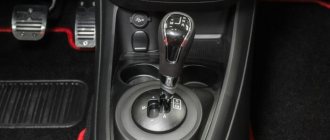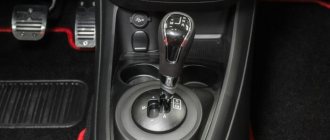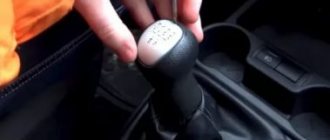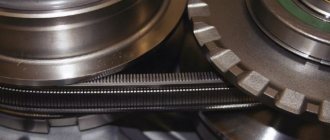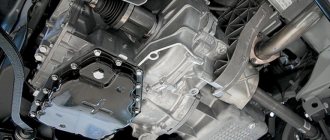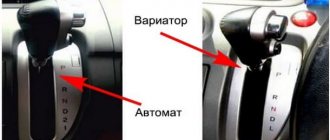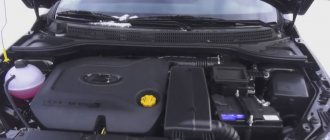As you know, various domestic models produced by AvtoVAZ have long been produced exclusively with a manual transmission. However, not so long ago the popular Lada Granta and Kalina received the long-awaited automatic transmission, which can rightly be considered a great success.
With the launch of the Lada Vesta model on the market, many car enthusiasts, for obvious reasons, also immediately turned their attention to the version with an automatic transmission. Next, we will look at what kind of automatic transmission is installed on the Lada Vesta now, as well as what automatic transmission options may appear on this model in the future.
Use of automatic transmission on Lada Vesta cars
In mass production, Lada Vesta with automatic transmission is equipped with an AMT robotic gearbox. It is based on the VAZ 21827 manual transmission. A control unit, drive and actuators from the German company ZF have been added to the manual transmission.
AMT automatically releases the clutch. To start driving, remove the selector from the neutral position and press the accelerator.
The robotic automatic transmission has a lot of shortcomings, which is confirmed by negative reviews from car owners and the low level of sales compared to the Lada Vesta with a manual transmission. A car with AMT jerks when starting off, and gear shifting is accompanied by jerks.
Many complaints about the automatic transmission arise from the slowness of gear shifting. This is especially noticeable during dynamic sports driving. The electronics turn on the required pair of gears at the wrong time. A similar problem occurs when driving uphill. The downshift is engaged with a noticeable delay.
A special feature of the AMT is the impossibility of parking on a slope without applying the hand brake. This is due to the fact that the car may begin to roll. This may lead to an emergency.
A robotic automatic transmission also has a number of advantages. It has a lower cost compared to a classic machine. The AMT in the Lada Vesta has protection against engaging the wrong gear, which conventional mechanics lack.
At the end of winter 2022, the plant in Izhevsk began production of the updated automatic transmission AMT 2.0. The box is free of most flaws and shortcomings. One of the main advantages is the appearance of the “crawling” Creeping Mode. It allows you to create the effect of a classic machine gun. The car starts moving immediately after releasing the brake pedal. Without pressing the gas, there is enough traction to overcome the speed bump.
The upgraded automatic transmission AMT 2.0 works much faster. The average gear shift time has decreased. But despite all the improvements, it is impossible to release the brake in “creeping” mode on an incline without using the handbrake. The test drive showed that the Lada Vesta manages to roll back before the automatic transmission engages first gear.
Slowness when changing gears has also been eliminated. The algorithm for turning on servos has been optimized. In this case, the switching speed is interconnected with the force of pressing the accelerator pedal.
A feature of the AMT 2.0 automatic transmission is that all modernization was carried out exclusively by software, without affecting the design of the box. Despite this, official dealers refuse to reflash old controllers.
From time to time, rumors arise that Vesta will be equipped with a classic automatic transmission. The most common assumptions fall on the Jatco JF414E. Despite this, company president Nicolas More denies the possibility of installing a four-band automatic transmission. Jatco JF414E is significantly outdated and is not suitable for Lada Vesta. The plant is working on creating a six-speed automatic transmission. The appearance of an automatic transmission on the Lada Vesta should be expected in 5-7 years.
conclusions
What conclusions can be drawn based on the above? Each transmission option will have its own pros and cons, strengths and weaknesses, advantages and disadvantages. Which one to choose, I think, everyone will decide for themselves.
If you are not spoiled by automatic transmissions, it’s easy for you to press the clutch and change gears yourself, and you don’t really want to bother with the nuances of operation and maintenance, then classic mechanics will be a good option for you.
If you want comfort and are willing to pay for it, then a robot or a CVT will be a good offer. In the comments, be sure to write which transmission option for the Lada Vesta is the best, and why. Share your ownership experience, write comments, ask questions.
All Lada Vesta engines. Detailed overview of available motors
Review of manual transmission on Lada Vesta
Initially, it was planned to install a VAZ-2180 manual transmission on the Lada Vesta. Due to increased noise and mediocre performance, company director Buandersson rejected the unit. Instead of the VAZ-2180, it was decided to install Renault JH3 mechanics.
In mid-2016, AvtoVAZ officially abandoned the use of a manual transmission from the French company Renault. The reasons for this were:
- non-competitive price of a foreign manual transmission;
- lack of sufficient base for maintenance;
- insufficiently good performance characteristics of the French box;
- placing the CV joint inside the box;
- an engineering miscalculation, which manifests itself in the loss of some oil from the gearbox when the CV joint boot is damaged;
- the pendulum is made one piece with the rod.
The company decided to modernize the existing VAZ 2180 gearbox. The improvement was successful. It was possible to create an almost new VAZ 21807 gearbox, which bypassed the Renault unit in most respects.
Engineers managed to achieve a significant reduction in noise levels. The gear shift pattern has become more balanced. The transition between speeds is smooth and comfortable, as the lever clearly falls into place.
Foreign technologies in a Russian car
During the design process, it was planned to equip the Vesta with a Russian-made manual transmission, but AvtoVAZ specialists were unable to get rid of the presence of noise in some stages. It was decided to use JH mechanics from the partner concern Renault-Nissan.
The JH installed gearbox is used on many foreign car models. It has proven itself to be a silent, high-quality manual transmission. The shift mechanics themselves moved to the upper zone of the transmission, which reduced oil consumption for operating a manual transmission and eliminated the defect of difficult gear changes caused in this mechanics by thickening the oil at low temperatures. The only drawback of introducing a foreign gearbox was the price of the manual, which for this gearbox is twenty percent higher than for its domestic counterpart.
The manual transmission on Vesta is installed in conjunction with two Russian engines VAZ 21116 and VAZ 21127.
The appearance of a variator on the Lada Vesta
Almost immediately after the presentation of the Lada Vesta to the public, there was talk about the possible configuration of the car with a CVT. In September 2022, the company officially confirmed testing with a CVT. A month later it became known that the Jatco JF015e unit was installed on the car.
In February 2022, AvtoVAZ representatives announced that the continuously variable transmission will be paired with a 1.6-liter Renault-Nissan engine.
In September 2022, the head of the press service announced the start of the preparation phase for the production of Lada Vesta with a continuously variable transmission. Final changes are being made to the car's design to allow the installation of a CVT. The company is negotiating with component suppliers. For the first time, the release date of the Lada Vesta with a CVT is announced. The first cars were supposed to go on sale at the end of 2022.
In November 2022, validation tests of the variator began on another model of the company's car. At the end of 2022, a postponement of the start of production of the Lada Vesta with a CVT is announced. The car's new release date is initially set for the third quarter of 2022. A little later, the debut of the Lada Vesta with a CVT is postponed to the fourth quarter of 2022.
According to the latest data published on 03/19/19 on the Lada Vesta production plan for 2022, the car in modification with the Jatco JF015e variator will appear on the assembly line in December of this year. The car with a continuously variable transmission should go on sale in early 2022.
The advantage of a CVT over a robotic automatic transmission is the ease of speed control. The continuously variable transmission allows you to accelerate smoothly, without dips or jerks. According to the manufacturer, the Lada Vesta should be more dynamic with a CVT.
Engineers promise the reliability of the continuously variable transmission at a very decent level. Provided that the car owner does not try to start a car with an automatic transmission from a pusher, participate in races, or storm high curbs, the CVT is expected to last 250 thousand km. At the same time, an oil change is necessary every 70 thousand km.
One of the main disadvantages of a CVT is that it is more expensive than a robotic automatic transmission and manual transmission. The additional payment can be 50-100 thousand rubles. At the same time, the torque limitation will not allow the use of a continuously variable transmission with the entire range of engines.
Good car for family trips
“I was pleasantly surprised by the capacity of the trunk: a children’s bicycle fit in without disassembling, a camping table and four seats, a camping gas stove, 4 250 ml gas cylinders. Four bags with things, packages... I didn’t expect that such a volume could fit in a sedan.”
, writes car enthusiast Nikolai from St. Petersburg.
“The trunk is huge, 3-4 trunks of 50 kg each can easily fit in, and even more if the rear seats are folded down.”
,” agrees a car owner with the nickname 3895621 from Khabarovsk.
“The glove compartment refrigerator held 2 liters of milk and food for three meals for a family of 4 on a long trip of 1000 km. The refrigerator works perfectly, nothing has spoiled in 1000 km. Another plus is a good air conditioner, which functioned properly all summer while the heat lasted.”
, writes Nikolai.
The trunk of the sedan is spacious (480 l). The configurations on the “fifteenth” and “sixteenth” wheels have a full-size spare tire under the floor.
The trunk of the sedan is spacious (480 l). The configurations on the “fifteenth” and “sixteenth” wheels have a full-size spare tire under the floor.
Main technical characteristics
Fuel consumption and other technical characteristics of the Lada Vesta depend on which gearbox is installed on the car. You can learn more about the main parameters of a vehicle with various transmissions in the tables below.
Actual fuel consumption differs from that stated by the manufacturer. This is due both to the influence of the environment and to the general condition of the vehicle. Below are the results of a survey of owners of Lada Vesta with manual transmission and AMT in one of the social networks.
Severe frost reveals shortcomings
“Dear AvtoVAZ, we don’t live in Africa!”
,” car enthusiast Alexander from Tynda appeals to the manufacturer. And he lists all the problems he encountered in the winter.
- The car cannot be locked with the engine running. I don’t want to set an alarm, there will be crickets in the cabin, like in Largus. You can’t leave your car outside for more than an hour, otherwise you’ll freeze to the seat. The heated seats help, though thanks for that;
- In cold weather the trunk lid does not close well. Change the lubricant in the lock, or make the spring more powerful, gentlemen, designers;
Automatic transmission reliability and service life
Increased clutch wear is often found on cars with Creeping Mode. This is especially noticeable when operating the car in traffic jams. Critical clutch wear can occur after a mileage of 20-60 thousand km.
Starting a car with an automatic transmission is accompanied by a vibration similar to a tremor. This causes a destructive effect on the engine and gearbox. Vibration also causes threaded connections to loosen. Tightening of nuts and bolts may be required after 5-10 thousand km of operating the car in traffic jams.
Typical manual transmission problems identified during operation
The domestic manual transmission has virtually no weaknesses. It is devoid of serious design flaws and has excellent reliability. There are questions mainly about French mechanics. The internal CV joint of the Renault box is placed directly into the unit. When the constant velocity joint is destroyed, its parts enter the working area of the gearbox. As a result, repairs with disassembly of the unit are required. A car owner may encounter such a problem when the mileage exceeds 50-70 thousand km.
During the operation of a Lada Vesta with JH3 mechanics, some car owners are faced with a situation where the amount of oil in the manual transmission becomes less. This is due to the CV joint boot. If it is damaged, the lubricant leaves the box little by little. This trouble can happen, for example, if you accidentally hit a branch.
It is important for the car owner to change the oil in the manual transmission in a timely manner. Otherwise, the unit will be subject to increased wear and major repairs will be required after a mileage of 90-130 thousand km.
Review of the feasibility of automatic transmission repair
The robotic automatic transmission of the Lada Vesta has a simple design. This determines its high maintainability. With timely oil changes before major repairs, the ATM can last 300-400 thousand km.
Purchasing a contract or new automatic transmission is only advisable if the original unit has a significant mileage. The cost of a unit from auto wrecking yards starts from 7-10 thousand rubles. A new automatic transmission can be purchased from an official dealer for 40-60 thousand rubles.
The choice between replacing and repairing a manual transmission
French-made manual transmissions are very repairable, but spare parts for their restoration are not always available. Therefore, sometimes it is easier to purchase a new or contract unit. The cost for a new manual transmission starts from 40 thousand rubles. The contract unit has a price of 6,000 rubles.
Domestic-made mechanical boxes are mainly repaired. From a major overhaul to the next overhaul, a manual transmission can cover 150-200 thousand km. Car owners usually buy a new box or contract unit only if the unit has serious deformations or significant wear. From an official dealer, a mechanic costs from 35 thousand rubles, and from a car wrecker - from 5,000 rubles.
It's just that the driver gets tired
«I couldn’t find a comfortable driving position with a height of 176 cm. I didn’t feel much discomfort on trips around the city lasting up to 2 hours, but on a long trip, about 500 km, my neck began to hurt terribly. After 1000 km the neck simply fell off. There is a retractable lumbar support, but there is no noticeable effect from it - I put it in the extended position. Those who plan to buy a car for long trips should carefully evaluate the comfort in the driver's seat.
“, warns Nikolay from St. Petersburg.
